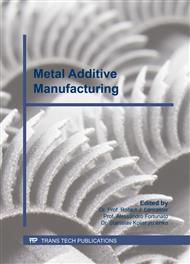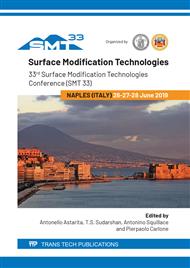p.165
p.171
p.178
p.185
p.191
p.197
p.203
p.209
p.215
In-Process Laser Re-Melting of Thin Walled Parts to Improve Surface Quality after Laser Metal Deposition
Abstract:
Laser metal deposition (LMD) is an additive manufacturing process highly adaptable to medium to large sized components with bulky structures as well as thin walls. Low surface quality of as-deposited LMD manufactured components with average roughness values (Ra) around 15-20μm is one of the main drawbacks that prevent the use of the part without the implementation of costly and time-consuming post-processes. In this work laser re-melting is applied right after LMD process with the use of the same equipment used for the deposition to treat AISI 316L thin walled parts. The surface quality improvement is assessed through the measurement of both areal surface roughness Sa(0.8mm) QUOTE and waviness Wa QUOTE (0.8mm) parameters. Moreover, roughness power spectrum is used to point out the presence of principal periodical components both in the as-deposited and in the re-melted surfaces. Then, the transfer function is calculated to better understand the effects of laser re-melting on the topography evolution, measuring the changes of individual components contributing to the surface roughness such as the layering technique and the presence of sintered particles. Experiments showed that while low energy density inputs are not capable to properly modify the additive surface topography, excessive energy inputs impose a strong periodical component with wavelength equal to the laser scan spacing and directionality determined by the used strategy. When a proper amount of energy density input is used, laser re-melting is capable to generate smooth isotropic topographies without visible periodical surface structures.
Info:
Periodical:
Pages:
191-196
Citation:
Online since:
July 2019
Price:
Сopyright:
© 2019 Trans Tech Publications Ltd. All Rights Reserved
Share:
Citation:



